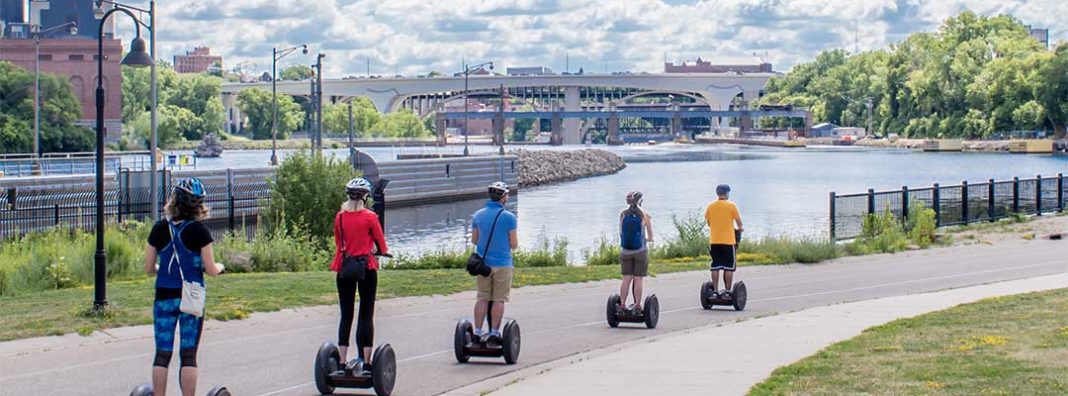
In late June, Fast Company broke the news that Segway Inc. would end production of the Segway PT, the self-balancing two-wheeled “personal transporter” that was the company’s most iconic product, if not its most commercially successful. Once touted as the first great invention of the new millennium, it officially ends its nearly 20-year-long production run on July 15 as the butt of more than a few jokes.
But was the Segway really such a failure? Or was it just two decades too early? In light of the current proliferation of e-scooters, e-bicycles, e-skateboards, and hoverboards, the electric urban mobility revolution that Segway promised seems downright prophetic. And its death holds important lessons for Segway’s would-be heirs.
The revolution-that-wasn’t launched in December 2001 with a light-hearted “Good Morning America” segment in Manhattan’s Bryant Park. Inventor Dean Kamen introduced the Segway as a “self-balancing human transporter,” with internal gyroscopes that “sensed” the direction that you wanted to go. The battery-powered device initially had a top speed of 10 miles per hour.
Expectations were oppressively high. “Segway will be to the car what the car was to the horse and buggy,” Kamen asserted. Steve Jobs thought the product would be just as important as the PC, while venture capitalist John Doerr predicted that Segway Inc. would be the fastest company in history to make $1 billion in sales. In a more subdued prediction, Kamen promised his product would finally offer a solution to public transportation’s notorious “last mile” problem, connecting people from train stations and bus stops to their home or office. He expected to sell 10,000 vehicles a week. America’s downtowns would become a sea of Segways as commuters clamped their briefcases to their trusty PTs and rolled to the office. “If enough of these become part of the infrastructure,” Kamen said, “what will happen is people will start to take back this very, very core of their cities.”
But from the start Segway had accessibility issues, with a conventional sales model and a $5,000 price tag. (By its final run, a Segway could run as high as $10,000.) This steep entry made consumer ownership a dubious proposition: In the end, only 140,000 units were sold, in total. The machines’ considerable cost, weight, complexity, and pokiness offered few practical advantages over more conventional vehicles like bicycles or motor scooters; they were as expensive as a used car but left their single driver/passenger completely exposed to the elements. Segway Inc. enjoyed more success with institutional users, working closely with organizations like the Postal Service, Amazon, and local police departments. Security guards and parking enforcement officers hopped aboard thousands of Segways, and fleets of Segway-mounted sightseers rolled around tourist destinations from D.C. to Jerusalem.
Instead of becoming a mass-market last-mile mover, the Segway became a slapstick prop in aughties hits like Paul Blart: Mall Cop and Arrested Development. A series of high-profile accidents, ranging from comical to tragic, didn’t help its image. In 2003, President George W. Bush famously fell while riding a Segway, raising concerns about the machine’s safety; Segway boss Jim Heselden, who’d purchased the company from Kamen in 2009, fell to his death a year later when the vehicle he was piloting plunged off a cliff.
Yet for all the mall-cop gags and PR disasters, the original vision of the Segway seems newly prescient in an age of abundant e-scooters and e-bicycles. Indeed, as these newer products find their footing in the mobility ecosystem, they owe much to the dorky grandfather of urban micromobility.
Segway’s current owner, Beijing-based Ninebot, says the PT sales were hampered by the vehicles’ sheer unkillability: “We have seen an over-saturation of the market for Segway PTs,” the company said in a statement. “They are an extremely durable vehicle, with many that are 10 years or older still on the road.” The Segway PT made up less than 1.5 percent of the company’s revenue last year. Their cash cow? Making rentable e-scooters for companies like Spin and Lyft. Ninebot supplies 70% of the global scooter industry with their fleets, the company says. Had that shared vehicle model existed back in the early 2000s, the original Segways might have stood a fighting chance. As with public bikeshare systems or dockless scooters today, urban users might have rented them for short rides, normalizing ridership and dealing with unresolved parking and storage issues.
Yet the Segway also faced the same challenges that continue to plague micromobility: overregulation and the general poor state of North American bicycle and pedestrian infrastructure. The debates over scooter-clutter and safety that dogged the mass rollout of dockless bikes and scooters in 2018 were anticipated by the early questions about just where the Segway was supposed to go. Too slow and vulnerable to flow with mixed traffic and too bulky for sidewalks, the Segway slammed into an unscalable infrastructural barrier: In 2001, fully protected bike lanes were rare in U.S. cities.
The result was an awkward patchwork of regulations, controlling where Segways could and couldn’t be used. A handful of cities, including San Francisco, banned them outright. And as recently as the mid-2010s, the Segway came under fire in one of its safest markets — tourism — with cities like Barcelona and Prague adopting partial Segway bans in response to complaints from locals.
Twenty years later, the same topsy-turvy regulatory environment continues to imperil micromobility, which remains subject to a chaotic patchwork of rules. To an even greater degree than with the Segway, many cities opted to ban e-scooters outright. Worse yet, unlike with the Segway, 17 states insist on treating small motorized devices like e-scooters as vehicles, complete with licensing and insurance requirements, making personal ownership a chore.
While the provision of protected bicycle lanes — the natural home for Segways and e-scooters alike (not to mention bicycles) — has improved in recent years, multimodal infrastructure remains limited in U.S. cities. In 2020, as in 2001, American transportation planning still heavily privileges dangerous, gas-guzzling cars over smaller street users. Companies like Lime have taken up the cause of lobbying for more micromobility-friendly lanes, and with good reason: Without safe places to ride them, e-scooters are fated to go the way of the Segway.
Perhaps the Segway wasn’t the world-changing breakthrough we were promised. Or perhaps we were just too cynical to let its playful spirit into our cities, and too unwilling to appreciate the possibilities that car-free urban mobility could offer. Reconsidered from this grim new age of techno-pessimism and sluggish innovation, the Segway looks more a breath of fresh air, an earnest opportunity to radically improve urban life and reclaim space from the automobile that we failed to take advantage of. Maybe we were just too out of balance to appreciate it.



 Bloomberg
Bloomberg